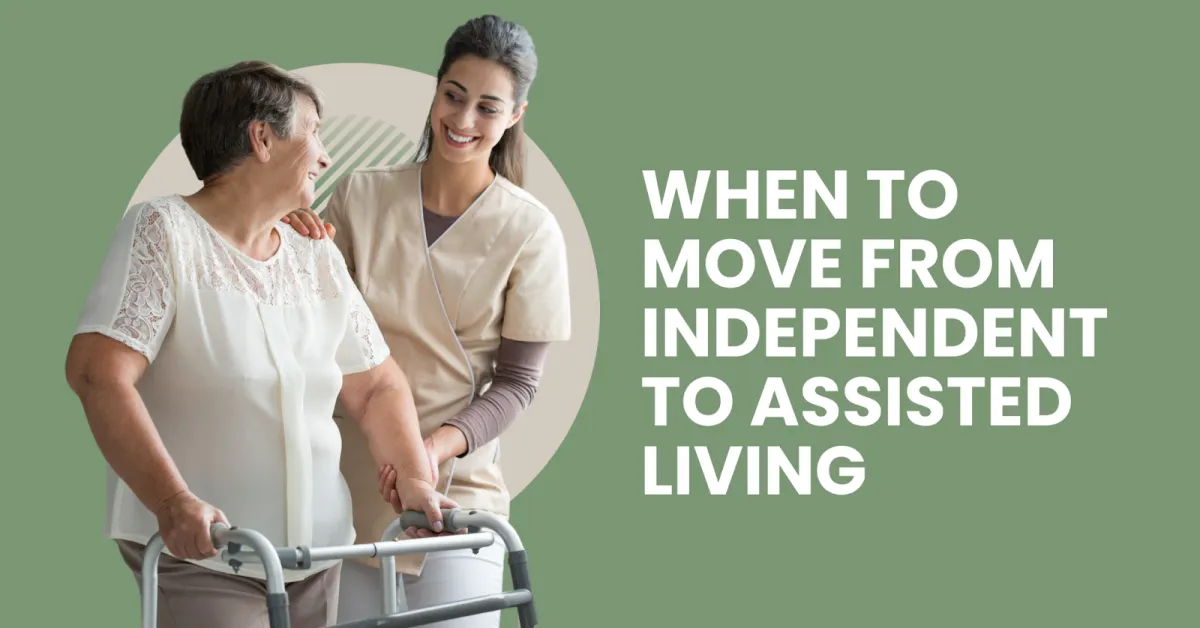
When to Move from Independent to Assisted Living
Making the decision to move from independent living to assisted living is significant. It involves recognizing changes in health, lifestyle, and daily needs. This guide will help you understand the signs for assisted living, the ideal age for it, and tips for a smooth transition.
It’s important to approach this decision with compassion and open communication. Involving your loved one in discussions about their preferences and concerns can ease the transition and reduce anxiety. By understanding their needs and exploring options together, you can ensure that the move feels less like a loss of independence and more like an opportunity for enhanced care and quality of life.
What is Assisted Living?
Assisted living provides support with daily activities while maintaining independence. Residents can access care for tasks like medication management, meal preparation, and housekeeping. It’s perfect for seniors who need help but don’t require 24/7 medical attention.
At Walnut Villa, we offer a variety of options to ensure comfort and safety for all residents. Explore our services and book a tour to learn more about our approach to assisted living in Whittier, CA.
Key Assisted Living Signs
Knowing when it’s time to transition is essential. Here are common assisted living signs to watch for:
Difficulty with Daily Tasks
Struggling with cooking, cleaning, or personal hygiene can indicate the need for assistance. These challenges can frustrate people. They may neglect important tasks, hurting their well-being. Identifying these signs early ensures timely intervention.
Increased Forgetfulness Memory loss, such as forgetting appointments or medications, is a common sign. This can also cause misplaced items and trouble recalling recent events. It leads to confusion and stress.
Safety Concerns at Home
Frequent falls or difficulty navigating the home suggest that we need a safer environment. Poor lighting, clutter, or limited mobility can worsen these risks. They require immediate attention.
Social Isolation
Withdrawal from friends or activities might point to loneliness or depression. Encouraging social interaction or group activities can increase mental health and well-being.
Chronic Health Issues
Ongoing medical conditions that require attention make transitioning to assisted living a wise choice. Regular medical care and professional monitoring can ensure stability and prevent complications.
Caregiver Burnout
If family members or caregivers feel overwhelmed, professional help may be necessary. We must meet caregiver needs. It's vital for their health. It ensures they can support their loved ones.
By recognizing these assisted living signs, you can plan a smooth transition and ensure your loved one’s well-being.
Ideal Age for Assisted Living
There’s no fixed age for assisted living, as everyone ages differently. However, many people transition between 75 and 85. The decision is less about age and more about physical, mental, and emotional health. Families often move seniors earlier to ensure their safety and quality of life.
It’s also essential to consider the individual’s social and emotional well-being. Isolation or difficulty maintaining relationships can significantly impact mental health, making assisted living a valuable option. Communities designed for seniors provide opportunities for meaningful social interactions, structured activities, and a sense of belonging, which can greatly enhance their overall happiness and quality of life.
If you see a decline in mobility or cognition, it's time to consider assisted living. Frequent hospital visits are another sign.
Tips for Transitioning to Assisted Living
Start the Conversation
Early Talk about the idea of assisted living before it becomes an urgent need. Open, honest communication allows time for thoughtful decision-making and helps reduce resistance later.
Visit Communities
Together Tour facilities like The Walnut Villa to help your loved one feel involved and comfortable. Directly experiencing the environment can ease worries. It shows what daily life is really like.
Personalize the Space
Bring cherished belongings to make the new home feel familiar. Photos, favorite furniture, and decorations can create comfort and belonging.
Stay Positive
Focus on the benefits, like social opportunities and improved care, to ease worries. Highlight activities or amenities that match their interests. This will make the transition more appealing.
Maintain Regular Visits
Frequent visits help create a sense of continuity and support during the transition. Regular, in-person communication and calls reinforce your presence and bond.
Transitioning can be emotional, but it’s also an opportunity to improve overall well-being. Our team at Walnut Villa is here to make this process easier.
Types of Senior Living Options
When considering a move, it’s essential to understand the different senior living types:
Independent Living
For active seniors who want a community environment without assistance. These communities offer activities, dining, and maintenance-free living to improve life.
Assisted Living
For those who need help with daily activities but want to maintain independence. Housekeeping, meal prep, and medication management services provide support and encourage independence.
Memory Care
Specialized care for seniors with Alzheimer’s or dementia. These facilities prioritize safety, routines, and activities. They aim to increase cognitive function and provide emotional comfort.
Skilled Nursing Facilities
For those requiring 24/7 medical care and rehabilitation. These facilities provide a higher level of care. They offer specialized treatments, therapy programs, and help with complex medical needs.
Assisted living bridges the gap between independence and full-time care. It offers the perfect balance for many seniors.
Benefits of Assisted Living
Moving to assisted living comes with several advantages:
Improve Safety
Professional staff ensures a secure environment. Emergency response systems and 24/7 supervision give residents and families peace of mind.
Social Interaction
Residents enjoy events, activities, and community connections. Group outings, hobby classes, and shared dining experiences foster friendships and reduce feelings of loneliness.
Better Health
Access to nutritious meals, exercise, and healthcare improves well-being. Regular wellness check-ups and customized care plans further improve overall quality of life.
Relieved Caregivers
Families find peace of mind knowing they care for their loved ones. This lets them prioritize their well-being while staying close to their loved ones.
By addressing the assisted living signs early, seniors can enjoy a better quality of life.
The Emotional Impact of Transitioning to Assisted Living
For many seniors and their families, transitioning to assisted living can be an emotional journey. Understanding these emotions and addressing them openly is essential for a smoother transition.
Fear of Losing Independence
One of the most common concerns is the fear of losing autonomy. Emphasize how assisted living supports independence while providing necessary help.
Guilt Among Family Members
Caregivers often feel guilty about the decision. Remember, choosing assisted living ensures better care and safety for your loved one.
Anxiety About Change
Moving to a new environment can be overwhelming. Gradual preparations and involving seniors in decision-making can ease the process.
Financial Considerations for Assisted Living
Affordability is another key factor when planning for assisted living. Here are ways to manage costs:
Assess Current Finances
Review your loved one’s income, savings, and assets. A clear picture of their finances helps to plan for assisted living costs.
Explore Long-Term Care Insurance
Some policies cover assisted living expenses. Review the policy details to determine what the coverage includes and ensure that you have the proper documentation in place.
Check for Veterans Benefits
Veterans and their spouses may qualify for financial assistance. Programs like Aid and Attendance can significantly ease the financial burden of care.
Consider Bridge Loans
Short-term loans can help cover costs while waiting for funds from a home sale or other assets. These loans provide flexibility and ensure timely payment during transitional periods.
Research State and Local Programs
Many states offer financial help for senior care. This can support eligible families.
Planning ahead can make the financial aspect less stressful and help families choose the best option for their loved ones.
Conclusion
Recognizing the assisted living signs is crucial for ensuring a smooth transition. You can improve your loved one's safety, health, and happiness. understand their needs and find the right community. Whether it’s time for a change now or in the future, planning is key.
For those in need of assisted living in Whittier, CA, The Walnut Villa provides a welcoming environment customized to seniors’ needs. Contact us to learn more about our services or schedule a tour today.
FAQs About Assisted Living
1. What are the top signs it’s time for assisted living?
Difficulty with daily tasks, frequent falls, and memory issues are key indicators.
2. What is the average age for assisted living?
While it varies, most seniors move between 75 and 85, depending on their needs.
3. How can families ease the transition to assisted living?
Start conversations early, involve your loved one in decisions, and personalize their space.
4. What types of senior living are available?
Options include independent living, assisted living, memory care, and skilled nursing facilities.
5. Why choose The Walnut Villa for assisted living?
At Walnut Villa, we prioritize safety, comfort, and personalized care for our residents.

Facebook
Instagram